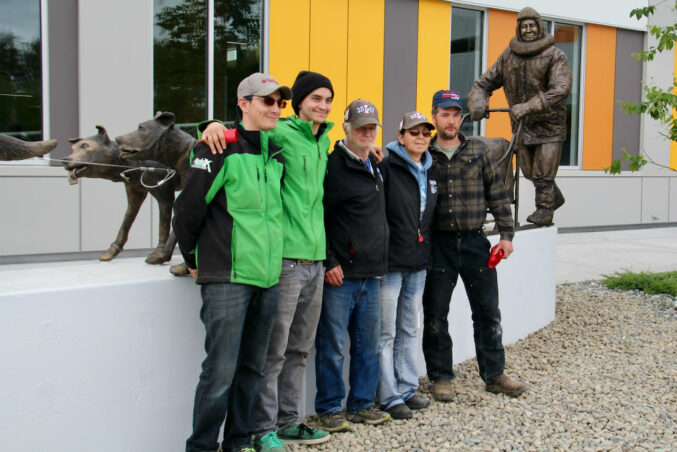
The Redingtons – A Family of Mushers. Photo Credit: Terrie Hanke
Redington. Seavey. Smyth. Mackey. At the 50th running of the Iditarod, these legendary family mushing dynasties were referenced again and again. The mushers and organizers of the first Iditarod committed to rescuing the sled-dog, and reviving the cultural significance of mushing to the history of Alaska. These values, and the love of mushing, have been passed down to their children, grandchildren, nieces, and nephews. The Iditarod, I’ve discovered, is all about family. Whether you are here because your grandfather ran it in the 70’s or because your dad read a random news story about a crazy 1,000 mile dog sled race in Alaska in your local paper; it turns out family has as strong a pull as any sled dog team.
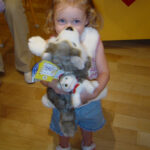
The day Ruffy, infamous stuffed dog, came into our lives. Photo Credit: J. Westrich
My journey began that way. In 2006 my 2 ½ year old daughter got a stuffed husky, Ruffy, and the questions started. “What kind of dog is this? What does a sled dog do? What is the Iditarod?” Her interest pulled my whole family along for the ride.
If you look at Iditarod photographer Jeff Schultz’s Faces of the Iditarod – which I STRONGLY recommend – you’ll meet hundreds of volunteers who cite family as the force that drew them to Iditarod. One of the first questions the project asks is “What, who, or how and when did you first get involved with the Iditarod?” In the answer to this question you get a picture of the volunteer dynasties – Guest, Owens, Doherty.
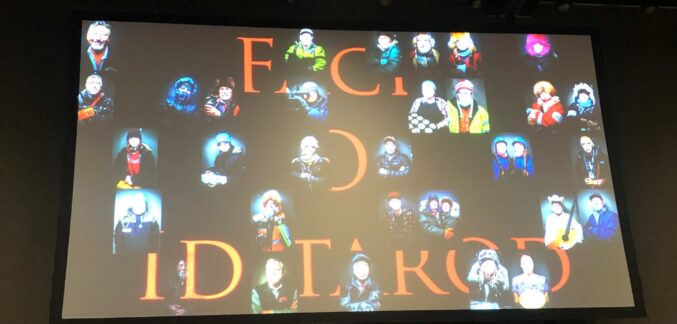
Faces of the Iditarod at the 50th Anniversary Gala. Photo Credit: J. Westrich
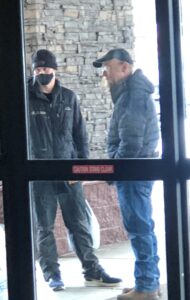
Dallas and Mitch Seavey have a father-son chat outside the Lakefront before they both run in the 50th Iditarod. Photo Credit: J. Westrich
These family ties make Iditarod a multigenerational event, which means there is an opportunity to teach Iditarod to a multigenerational audience. As I pondered this, I recalled some of my earliest work in Museum Education. I’ve been on a team that developed projects for high school students at the National Archives, created content for a senior citizen audience at the US Navy Memorial Museum, jumped all-in with the littlest learners at the Smithsonian Early Enrichment Center, and I now focus on elementary school kids. Learning occurs at every age, and it can’t be denied that Iditarod makes learning exciting.
So how can we leverage the engagement of Iditarod to inspire, inform, and grow the multigenerational Iditarod family?
I want to inspire students to be curious explorers who seek information and find answers to their questions about the world. Through collaborative, intergenerational learning students see that life should be filled with discovery and wonder, inside and beyond the classroom. Learning never stops, regardless of age, and by fostering a lifetime of inquisitiveness we encourage students to learn alongside their elders.
This dynamic gives adults an opportunity to share expertise, for students to demonstrate their knowledge, and to collectively grow as learners together. For several years my children’s school district had a program called G2 (Generation 2) which partnered senior citizen volunteers with classrooms. Learning about Iditarod in this setting and following the race together would be an ideal way to forge intergenerational connections.
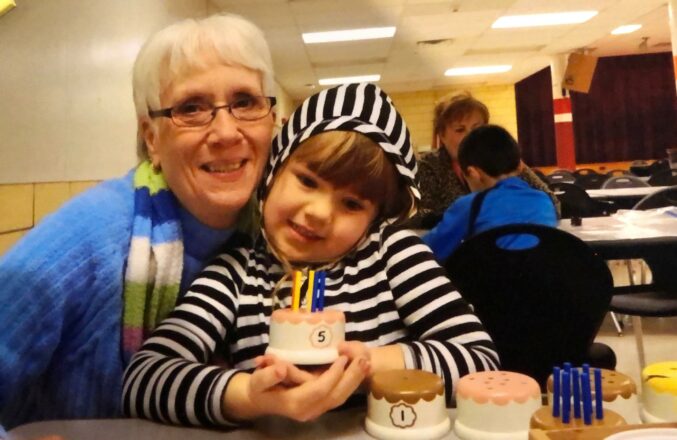
Collaborative Learning in the G2 program. Photo courtesy Mary Jude Ostrander
There is also the opportunity to broaden the reach of Iditarod as an educational tool. Senior centers and libraries run enrichment programs for adults, an excellent opportunity to teach Iditarod to a new (older) audience, who can then share with their kids and grandkids. Colleges across the country have degrees in sports management, Indigenous History, and pre-vet programs that would benefit from incorporating the unique dynamics of the Iditarod into their curricula. This is a chance to expand the Iditarod family, inviting adult learners into the fold.
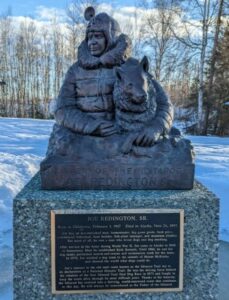 Joe Redington, Sr. statue at Iditarod Headquarters. Photo Credit: J. Westrich |
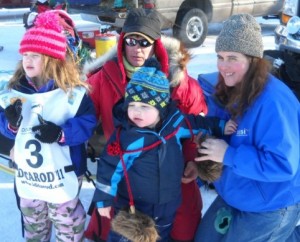 Ray Redington, Jr. and his wife, Julia, and their children, Ellen & Isaac, 2011. Photo Credit: Iditarod |
Father of the Iditarod, Joe Redington, Sr., started the Iditarod 50 years ago. Son Raymie finished Iditarod ten times and son Joee finished twice. Joee is a celebrated sprint musher, Fur Rondy Champion and was Iditarod’s Honorary musher in 2018. Grandsons Ray Jr, Ryan and Robert are all Iditarod finishers. Ray Jr has finished 17 races with 6 top ten finishes, Ryan has completed 8 races with 3 in the top ten and Robert completed his rookie run in 2017. The three brothers all finished the 2017 race. The next generation, Ellen and Isaac, Ray Jr’s children, are both competing in the Jr. Iditarod this year. Ellen and Isaac’s parents, Ray Jr. and Julia Flodin met while competing in the 1991 Jr. Iditarod. Iditarod is a family affair, an opportunity for multiple generations to share in an event that inspires, challenges, and engages the imagination of young and old. Expanding lesson opportunities to reach across generations will grow the Iditarod family for another 50 years.
Library Learnings: There are many wonderful books to support the concept of multigenerational learning and sharing knowledge at any age. The Kamik stories, inspired by the real-life recollections of an elder from Arviat, Nunavut are a great example to show how important it is to learn from older generations and to appreciate the knowledge they have to share. Drawn Together by Minh Le, Mango, Abuela and Me by Meg Medina, and Swashby and the Sea by Beth Ferry are additional stories that focus on knowledge sharing between generations. These stories are a great jumping off point for discussions about the ways your students connect with older adults in their families/communities.
Alternatively, as a parent I have learned about several new activities due to the interests of my children – Irish dance, figure skating, karate, to name a few. Do your students have an activity or topic they helped a parent or grandparent learn more about? Perhaps a video game, tiktok dance, or even the Iditarod?


